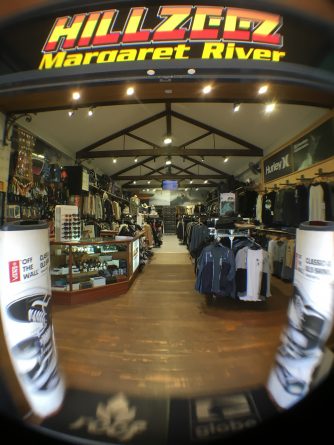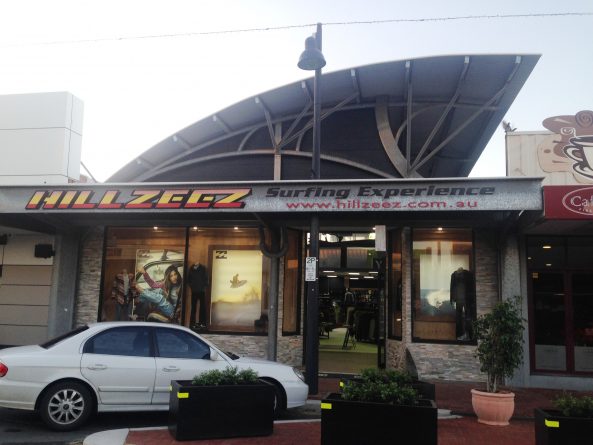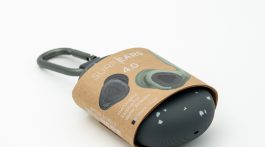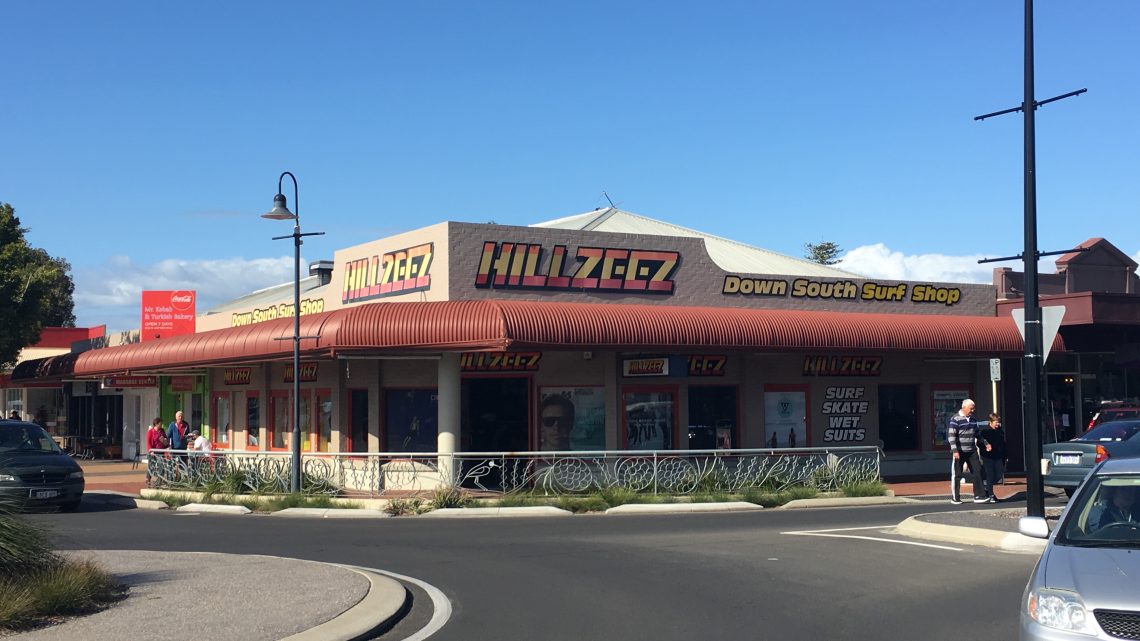GLENN CALLEGARI
Back in 2002 Glenn Callegari was working in a corporate accounting job in Perth when he saw an ad for a surf shop chain looking for an internal accountant, based in WA’s southwest. The job was at Hillzeez, which was then a three-store chain, owned by two partners. Both those partners have now gone, Glenn taking over ownership of the business in 2011, and he’s now had 15 years in surf retail.
The business now includes five Hillzeez surf stores and three Subculture stores, which are more urban oriented. Hillzeez won the WA retailer of the year at the 2016 SBIA awards and Reggae Elliss caught up with Glenn recently to get his thoughts on surf retail and where it is headed.

You now have five “Hillzeez down south” surf shops and three Subculture stores. When did you start and what was the evolution to five stores?
It all started from my response to a recruitment ad in 2002 – Surf Shop Chain seeking internal accountant in the south west of WA. I was then in a corporate accounting gig in Perth at Wesfarmers and part way through my postgraduate CPA qualification. I figured having SME experience to complement my ASX corporate time would diversify my resume, and hold me in good stead for future job roles. The thought bubble was to do a year or two back in the southwest, then join some mates overseas. It was a popular time to work abroad and accelerate your savings back home as the AUS dollar was hovering around 50c.
Little did I know that landing the job was the beginning of a long career in retail – now coming up 15 years.
How was the business operating when you came on board in the accounting role?
Hillzeez was then a three-store chain with three-fold reporting problems – owned by two business partners. Both had complementary strengths – one was a brilliant marketer, the other an exceptionally disciplined financial steward. I learnt a lot from both. One partner bought the other out, and eventually gave me the opportunity of outright ownership later in 2011.
You obviously knew the business well at that stage, so no reservations in taking the opportunity to buy Hillzeez?
I thought if I was ever going to swing the bat – it was the time. The health of the economy had taken a hit, and we’d come out of an artificially stimulated post GFC era (Ruddy money helped open store 4 late 2009). Even though our top line sales and margins were impacted, I was confident that internally, the business model was very sound. I was the exit strategy for the owner, and he was my entry strategy. Investment in systems, structures and people didn’t cease pre, during or post-handover, thus there was no speed bump whilst we agreed terms. A lot of mutual respect existed between us and we reached an outcome that was reflective of this.
And you’ve continued to expand the business since you took over.
Yes. A couple of years later I added Margaret River to the core surf store group taking it to five, and over the past three years I’ve added three Subculture stores in the southwest, which I saw as an urbanised diversification of surf. I may see it different to most, but at risk of confusing our identity, in 2013 I felt the need to start drawing a line between core surf brands and other lifestyle labels. Subculture facilitated this and we are able to define our customers better for each of the complementary doorways.
Retail has been through some well-publicised difficult times over the past 10 years. How have you ridden it out and how do you see the next five years for your business?
I could say I experienced a GFC in 08-09 but the truth is the WA economy was largely incubated thanks to the largely Chinese driven mining boom. Strong real wage growth continued late in the decade, unemployment stayed low and house values held true after at least doubling in most areas while interest rates plummeted.
Federal stimulus was warranted for the broader national picture, but WA did not need it. It added to the inflated pool of disposable income and pushed us to unsustainable heights. It was a great time to be a retailer – our consumers had a spending party, but we are now dealing with a big hangover after our economy corrected hard over the last two to three years. It’s hard to argue the claim many make – we saw the rise and fall of the cashed up bogan.

Since the downturn in commodity prices, the WA economy is pretty fragile.
Iron ore prices today are still around a third of what they were at the height of 2011. Our inept state government became dependent on the mining royalties, so the state is now broke. We get shafted by the federal government with GST – only 30c of each dollar raised comes back to our state finances. If split by population share we would be getting 6.7 billion, instead we get 2 billion, the rest goes to other states due to a ridiculous agreement in 1999.
Payroll tax is now 40% of state revenue (up from 26% a decade ago) and this “fine for employing people” has grown threefold in the last five years due to my wage growth. Thus it’s a tough state to do business.
A lot of that is out of your control, but how do you react to the adverse conditions? Do you see any possibility of turnaround on the horizon?
As bad as it is now – the next five years are about continual quality improvement. Better business analytics, better reporting tools – making more right decisions. Marketing is critical – as opposed to just advertising. Our staff must always understand they are my marketers. The value in our advertising is diminished if it’s just reminding a consumer of a bad in store experience, the holes in our stock model, or unhelpful dialogue around product knowledge. Today’s environment won’t forgive sloppy execution.
Also, unique selling propositions are a must; particularly in an industry that has had it value proposition eroded by some bad distribution choices to large promotional pure play online players.
I’ll continue my focus on brands that understand the metrics of the Australian market. Brands that are making sustainable distribution choices.

With multiple stores you obviously need a good management team and good staff. What do you look for in someone when hiring and how do you keep the good ones?
We look for people wanting more than just a paycheck out of the job. Someone who wants to be part of a positive culture, that doesn’t want to be another number for another national player. Someone that can work under a medium-sized business framework but have enough autonomy in their role to put their creative juices into merchandising, staff training, customer service and the likes. Good people want to be stimulated in the job, recognised for their achievements and supported around the clock. We provide all of that to attract the right people. Culture is king.
“Good people want to be stimulated in the job, recognised for their achievements and supported around the clock. We provide all of that to attract the right people.”
All regional areas have their own issues and often run as a micro-economy that is different from major metro areas. What are some of the challenges unique to your part of the world?
With commodity prices in free fall over the last two years we are now having a WA-FC. It’s currently the toughest environment I have experienced. Unemployment up, real estate down – paper value eroded. Commercial rents are sticky, taking a very long time to correct. We’ve also experienced a decentralisation of the retail landscape in our regional trade zones. The number of Coles and Woolworths stores has nearly doubled in the last 10 years. It seemed like a scramble to future proof distribution. Aldi are also quite aggressive in their rollout program.
These anchors once created incidental foot traffic near our doorways, now they have replaced the corner store in every large-scale housing development. Thus it’s never been more important than to be a destination in our own right.
At a state level, Perth is where the population is. I do feel my supply chain forgets this when seeking distribution options. Well over 80% of the population lives in Perth. The increase in the number of people living in Perth each year (+50k) alone is bigger than the entire population base of each of my trade zones. Thus I question the modeling, or lack thereof, of many brands that want a bigger share of the state pie by looking south. The southwest and great southern is saturated. In every which way you could possibly measure it.
What about the surf industry as a whole. There has been a lot of change over the past decade, what are some of the challenges surf retailers are facing and what are the solutions?
I often think of the 15-year-old of 10 years ago – that kid is 25 today – and the number of brands that have competed for his/her share of wallet spend has never been bigger. And consumer access to product is now global. Therefore it’s really important to continually qualify my support levels for brands at each indent period. Apply the right filters and hopefully make the right decisions.
Brands that seek growth on growth, even when supply is ahead of demand – are a big problem. The resistance to resize means rogue distribution to off-price conduits becomes a requirement to hold “mythical” market share.
I have heard this from a number of retailers over the past couple of years. Is there a solution?
The solution for me is to open up dialogue with brands – get an understanding, and qualify if their future pathway is likely to be a sustainable one. If not on the same page, we will focus our energies elsewhere. It was more difficult a couple of years ago but becoming a clearer picture today. The pack is starting to split and mature brands are strategising their future correctly.
Two more things have also evolved quickly over the last decade. Brands have lost all measurement on product reach. Large national key retail accounts don’t share local information and online will sell anywhere. I therefore understand that gauging performance in a territory has become increasingly difficult for each brand. What I don’t understand is the ignorance of some of these brands that conveniently forget about these national accounts when assessing my support levels. These key accounts are in my territories, targeting my customers. Online and offline.
I tell brands just because you can’t measure it, doesn’t mean you can forget it.
What irritates me more is when some brands tell me independents are the most important part of their future. But give better trading terms to these national accounts, while agreeing how damaging they are for the industry?
Deflation is another issue. The cost of business is pushing our breakeven sales higher every year. Despite producing the most innovative and technically correct product in the history of the industry – there seems to be resistance to raise prices. It’s madness.
Key accounts have responded by going vertical in search of superior margins. There didn’t seem to be any brand backlash so I wonder if it’s the future of the independent also.
“All I know right now is that it starts with the right brands with the right distribution, distribution that respects the value proposition at RRP.”
Say a tee shirt 20 years ago pre GST was $36 (now $40 inc).
The price point indexed to my occupancy cost over this period is now $106. If stocking $40 options we need up to 3 more stock turns from the same square metre to achieve a neutral position. Wages and utilities have also gone up 250% in this time. It’s hitting breaking point.
The complete answer is a broader topic. All I know right now is that it starts with the right brands with the right distribution, distribution that respects the value proposition at RRP.
Your stores won the WA Surf Retailer of the Year at the recent SBIA awards. Is that something you value? What attributes do you think your business has that lead to the award?
Yes, we value the acknowledgement because it doesn’t come around that often.
To share it with the team was the best part. It created a lot of local publicity also – this actually took me by surprise. I guess we often come to the conclusion we can’t stay static in a dynamic space. If we aren’t in the game, we should get out.
So by default we look to how we can do things smarter all the time. It never stops. And there are many things on the roadmap right now.
Perhaps that has filtered through the judging process when assessing particular attributes. That said, all independents that are surviving in the current economic climate are deserving of an award here in WA.
There has been some discussion lately about the evolution of the four-seasons range release and possibly re-aligning the season’s drops so they are more in line with the actual seasons people are experiencing.
We all know there’s not much sense in having winter wear in February. What are your thoughts on that and what changes would you like to see?
The discussion is good and I welcome it. It’s centred about what and when. If the premise is to restore the value proposition I would argue a third element – to whom – is required. The beneficial outcome of realignment only materialises when chosen distribution (retail and pure play) buy to this strategy, enforce discipline and execute a premium message at the key times of year.
Full price new season jackets and fleece in May/June – full price board shorts and tees in December/January? I would love to see it happen, however the story board of the last 5 years would suggest it’s not on the agenda for some.
“Full price new season jackets and fleece in May/June – full price board shorts and tees in December/January? I would love to see it happen.”
Put simply, if brands continue to co-exist in premium and discount distribution space with homogenous product, no strategy will work. It’ll be more wasted energy.
And how do you think the “Four Seasons” range release has gone?
The resource burn of four seasons has led to ineffectiveness. I agree on sell thru – not to philosophy, I just question how fanciful it is when more sales rep hours each year are chewed up at another range release, or in showrooms showing yet another range.
Four seasons also narrowed the science into four buying blocks and came with mixed, sometimes vague messaging from participating brands.
Everyone must remember there is very little to any visibility of the season that runs subsequent to the season we are ordering. This is a big problem.
For example, our key boardshort sell through (Dec qtr. indent, now Summer, previously Hi Summer) is always achieved from late December to March.
Summer Showroom question: I need some guidance – how deep to I go? What will the Jan-Mar offering look like?
Summer Showroom answer: Dunno, I’d load up on key styles cos there isn’t any guarantees….
How do you see it panning out?
Because we only ever get a road map based on a three-to-four month indent window with a five-to-eight month lead-time, we build a future stock model today on “knowns”. I’m not sure brands can share information beyond the next indent because they may not know themselves.
For this reason I favour the ranges for the periods suggested below. I emphasise the word “ranges” as opposed to seasons. The responsibility will always fall on the brand to decide the months of product availability within the range.
Before I get the “big continent” argument I’m not saying fleece and boardshorts should be excluded from particular months. But width of offering definitely needs to be visited.
What would you like to see happen with range delivery?
If we are really serious about pushing the “discount calendar” back it would need a serious tweak:
Range 1 March – July (5 months) – typically Autumn/Winter merged
Range 2 August – November (4 months) – typically Spring
Range 3 December – February (3 months) – typically Summer
I can hear the dismissal already. But that is the risk – to make minor changes to a broken indent cycle. The reason I don’t suggest equal bocks of time, is because it’s not equal! Resources need to be aligned to when the revenue is generated. Right through the value chain. Having delivery for 12 months of the year will continue and is nothing new. We said that when 4 seasons was introduced. But we need to rid ourselves of any notion that a product only has a three-month life cycle. I feel four seasons has promoted this right across the category tree yet all the data I collate doesn’t support it. New product each month – a must. But it doesn’t mean that when a summer boardshort arrives in store, the “spring” version of the boardshort needs to be immediately discounted as though it’s no good. It may have only been indented 30 days prior.






